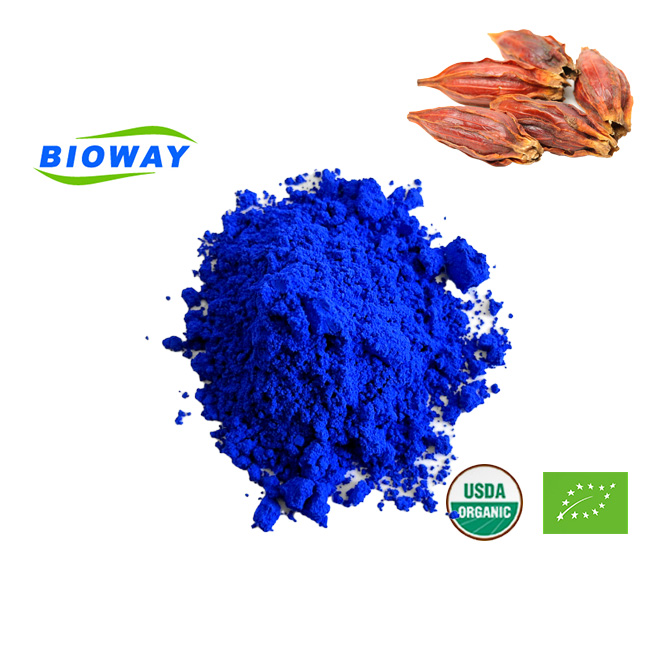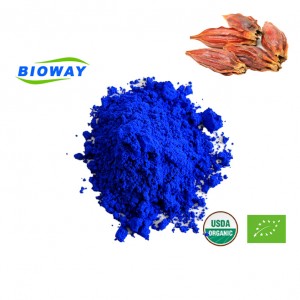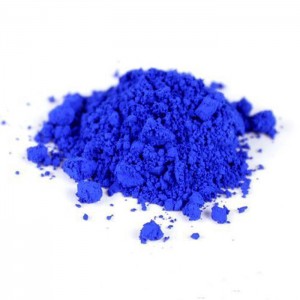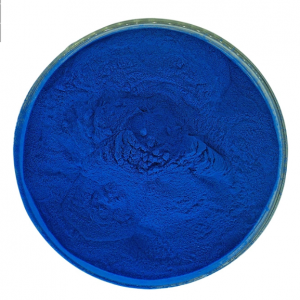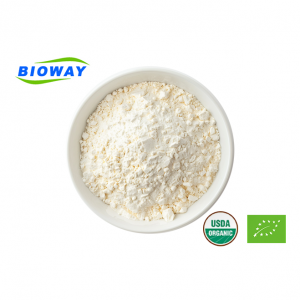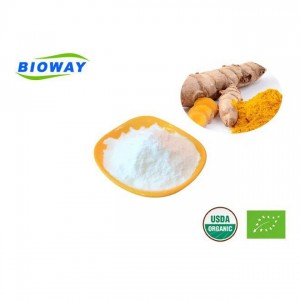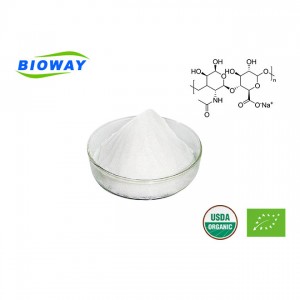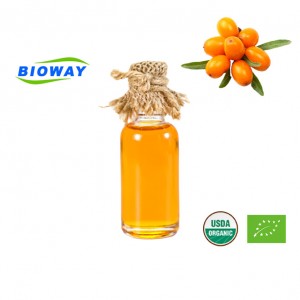Natural Color Gardenia Blue Pigment Powder
Natural Color Gardenia Blue Pigment Powder is a powdered pigment derived from the blue color of the Gardenia plant (Gardenia jasminoides). It is a natural and plant-based alternative to synthetic blue food colorings or dyes. The pigment is extracted from the Gardenia fruit, which contains a compound called genipin that contributes to its blue color. This powder can be used as a natural food colorant in various applications, including baking, confectionery, beverages, and other food products that require a blue color. It is known for its vibrant and intense blue hue, as well as its stability in different pH levels and temperature conditions.
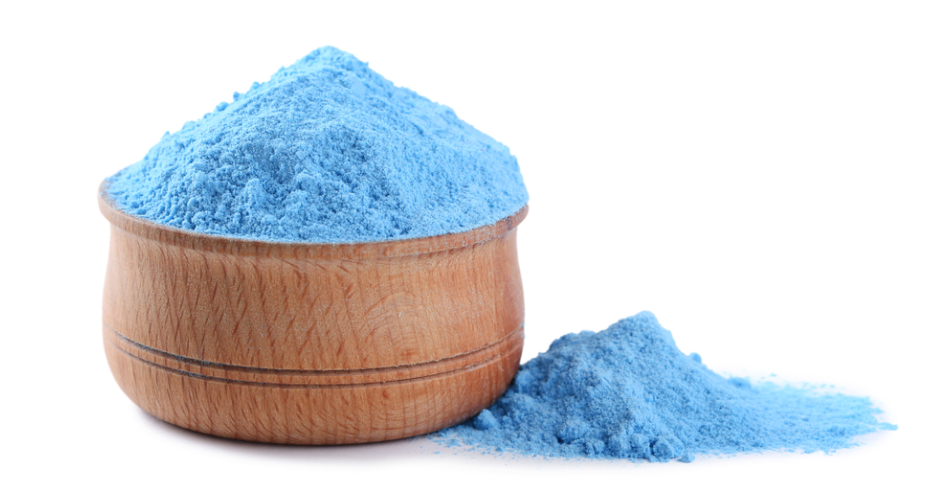
| Latin Name | Gardenia jasminoides Ellis |
ItemsRequirementsColor Value E(1%,1cm, 580nm-620nm): 30-220
| Item | Standard | Test Result | Test Method |
| Appearance | Blue fine powder | Conforms | Visual |
| Particle Size | 90% over 200 mesh | Conforms | 80 mesh screen |
| Solubility | 100% soluble in water | Conforms | Visual |
| Moisture Content | ≤5.0% | 3.9% | 5g / 105°C / 2hrs |
| Ash Content | ≤5.0% | 3.08% | 2g / 525°C / 3hrs |
| Heavy Mental | ≤ 20ppm | Conforms | Atomic absorption method |
| As | ≤ 2ppm | Conforms | Atomic absorption method |
| Pb | ≤ 2ppm | Conforms | Atomic absorption method |
| Pesticide Residues | ≤0.1ppm | Conforms | Gas chromatography |
| Sterilization Method | High temperature, high pressure | Conforms | |
| Total Bacteria Count | ≤1000cfu/g | Conforms | |
| Total Yeast Count | ≤100cfu/g | Conforms | |
| E. Coli | Negative | Conforms | |
| Salmonella | Negative | Conforms | |
| Staphylococcus | Negative | Conforms |
1. 100% Natural: Our Gardenia Blue Pigment Powder is sourced from Gardenia plants, making it a natural and plant-based alternative to synthetic blue food colorings or dyes. It does not contain any artificial additives or preservatives.
2. Vibrant Blue Color: The pigment is derived from the Gardenia fruit, known for its vibrant and intense blue color. It provides a beautiful and eye-catching blue hue to your food and beverages.
3. Versatile Application: Our pigment powder is suitable for various food and beverage applications, including baking, confectionery, desserts, beverages, and more. You can use it to enhance the visual appeal of a wide range of products.
4. Stability and Performance: The natural Gardenia Blue Pigment Powder is stable across different pH levels and temperature conditions, maintaining its vibrant blue color and performance even in challenging food processing environments.
5. Safe and Non-Toxic: It is free from harmful chemicals and additives, making it a safe choice for food and beverage coloring. Our pigment powder is also GMO-free and gluten-free.
6. Enhances Natural Labeling: By using our Gardenia Blue Pigment Powder, you can meet the growing demand for clean-label and natural food products. It allows you to add vibrant blue color to your products without compromising on the natural proposition.
7. Easy to Use: The powdered form of our pigment makes it easy to incorporate into your recipes. It dissolves readily in liquids, making it convenient to mix into your food and beverage formulations.
8. High-Quality Standards: Our Gardenia Blue Pigment Powder is carefully processed and tested to meet the highest quality standards. We ensure consistency, purity, and color stability in every batch.
By highlighting these selling features, you can showcase the uniqueness and value of our Natural Color Gardenia Blue Pigment Powder to potential customers.
There are several benefits of using Natural Color Gardenia Blue Pigment Powder:
1. Natural and Plant-Based: The pigment is derived from Gardenia plants, providing a natural and plant-based alternative to synthetic blue food colorings. It is free from artificial additives, making it a healthier choice for coloring your food and beverages.
2. Intense and Eye-Catching Blue Color: Gardenia Blue Pigment Powder offers a vibrant and intense blue color. It can add a visually appealing touch to your culinary creations, making them more attractive and appetizing.
3. Versatile Applications: This pigment powder is suitable for a wide range of food and beverage applications. Whether you're baking, making beverages, or creating desserts, you can easily incorporate the Gardenia Blue Pigment Powder to achieve a beautiful blue color.
4. Stability and Performance: The natural pigments in the Gardenia Blue Pigment Powder are stable and reliable. They can withstand various pH levels and temperature conditions, ensuring the color remains vibrant and consistent throughout the cooking or baking process.
5. Clean and Natural Labeling: Using Natural Color Gardenia Blue Pigment Powder allows you to meet the growing demand for clean label and natural food products. It enables you to add a visually appealing blue color to your products without the need for artificial dyes or colorings.
6. Safe and Non-Toxic: The Gardenia Blue Pigment Powder is safe for consumption as it is free from harmful chemicals and additives. It is also suitable for individuals with dietary restrictions such as gluten-free or GMO-free preferences.
7. Easy to Use: Incorporating the Gardenia Blue Pigment Powder into your recipes is effortless. It comes in a powdered form that easily dissolves in liquids, making it convenient to mix into your food and beverage formulations.
8. High-Quality Standards: Our Natural Color Gardenia Blue Pigment Powder undergoes rigorous testing and quality control measures to ensure consistent and reliable results. You can trust that you're using a high-quality product in your culinary creations.
Overall, the Natural Color Gardenia Blue Pigment Powder offers a natural, vibrant, and versatile blue coloring option for your food and beverage products, allowing you to meet consumer demands for clean, natural, and visually appealing products.
Natural Color Gardenia Blue Pigment Powder can be used in various application fields, including:
1. Food and Beverage Industry: Gardenia Blue Pigment Powder can be used to add a natural blue color to a wide range of food and beverage products such as beverages, dairy products, baked goods, confectioneries, desserts, ice creams, sauces, dressings, and more.
2. Culinary Arts: Chefs and food artists can use Gardenia Blue Pigment Powder to create visually appealing dishes and enhance the presentation of their culinary creations. It can be used for decorative purposes, coloring batters, doughs, creams, frostings, and other food preparations.
3. Natural Cosmetics: The vibrant blue color of Gardenia Blue Pigment Powder makes it suitable for use in natural cosmetics, such as soaps, bath bombs, body lotions, bath salts, and other personal care products.
4. Herbal and Traditional Medicine: In herbal and traditional medicine, Gardenia Blue Pigment Powder can be utilized for its potential health benefits and as a natural colorant for herbal extracts, tinctures, infusions, and topical remedies.
5. Art and Crafts: Artists and crafters can use Gardenia Blue Pigment Powder as a natural dye for fabrics, papers, and other artistic or craft projects.
It's important to note that specific usage levels and application techniques may vary depending on the desired intensity of the blue color and the specific requirements of each application field. Always follow the recommended guidelines and consult with regulatory authorities if necessary.
Provide you with a general description of the production process for Natural Color Gardenia Blue Pigment Powder:
1. Harvesting: The production process starts with the harvesting of Gardenia fruits, typically from Gardenia jasminoides plants. These fruits contain pigments called gardenia blue, which are responsible for the blue color.
2. Extraction: The gardenia fruits are processed to extract the pigments. This extraction process involves various methods such as grinding, maceration, or solvent extraction using food-grade solvents like ethanol.
3. Purification: The extracted pigments are then purified to remove any impurities or unwanted substances. This step can include filtration, centrifugation, and other purification techniques.
4. Concentration: After purification, the pigment extract is concentrated to increase the pigment's potency and intensity. This can be achieved by evaporating the solvent or using other concentration methods.
5. Drying: The concentrated pigment extract is dried to remove any remaining moisture. This can be done through spray drying, freeze drying, or other drying methods.
6. Grinding: The dried pigment extract is ground into a fine powder to achieve the desired particle size and texture. This grinding process ensures easy dispersion and incorporation into various applications.
7. Testing and Quality Control: The final Gardenia Blue Pigment Powder is tested to ensure it meets quality standards and regulatory requirements. This includes testing for color intensity, stability, purity, and any potential contaminants.
8. Packaging: Once the pigment powder passes quality control tests, it is packaged in suitable containers or packaging materials, ensuring proper sealing and protection from light and moisture.
It's important to note that the specific production process may vary among manufacturers, and some additional steps or variations may be employed based on the desired characteristics of the final product.

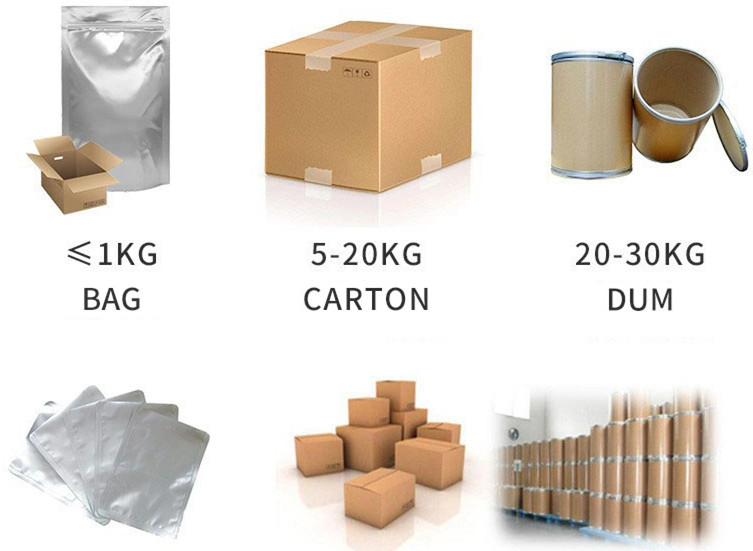
Express
Under 100kg, 3-5Days
Door to door service easy to pick up the goods
By Sea
Over300kg, Around 30 Days
Port to port service professional clearance broker needed
By Air
100kg-1000kg, 5-7Days
Airport to airport service professional clearance broker needed

Natural Color Gardenia Blue Pigment Powder is certified by Organic, BRC, ISO, HALAL, KOSHER, and HACCP certificates.

Some potential disadvantages of Natural Color Gardenia Blue Pigment Powder may include:
1. Limited stability: Natural color pigments can be sensitive to light, heat, pH, and other factors, which may affect their stability and color intensity over time.
2. Ingredient source variability: As natural pigments are derived from botanical sources, variations in plant species, growing conditions, and harvesting methods may result in inconsistent color output.
3. Cost: Natural color pigments, including Gardenia Blue Pigment Powder, can be more expensive compared to artificial color alternatives. This higher cost may limit their use in certain applications.
4. Restricted application range: Gardenia Blue Pigment Powder might not be suitable for all food and beverage applications due to factors such as pH sensitivity or limited solubility.
5. Regulatory considerations: The use of natural color additives is subject to regulatory guidelines and restrictions imposed by food safety authorities. Complying with these regulations may require additional testing and documentation.
It's important to note that these disadvantages are specific to the natural color pigment itself and individual product formulations may vary.

